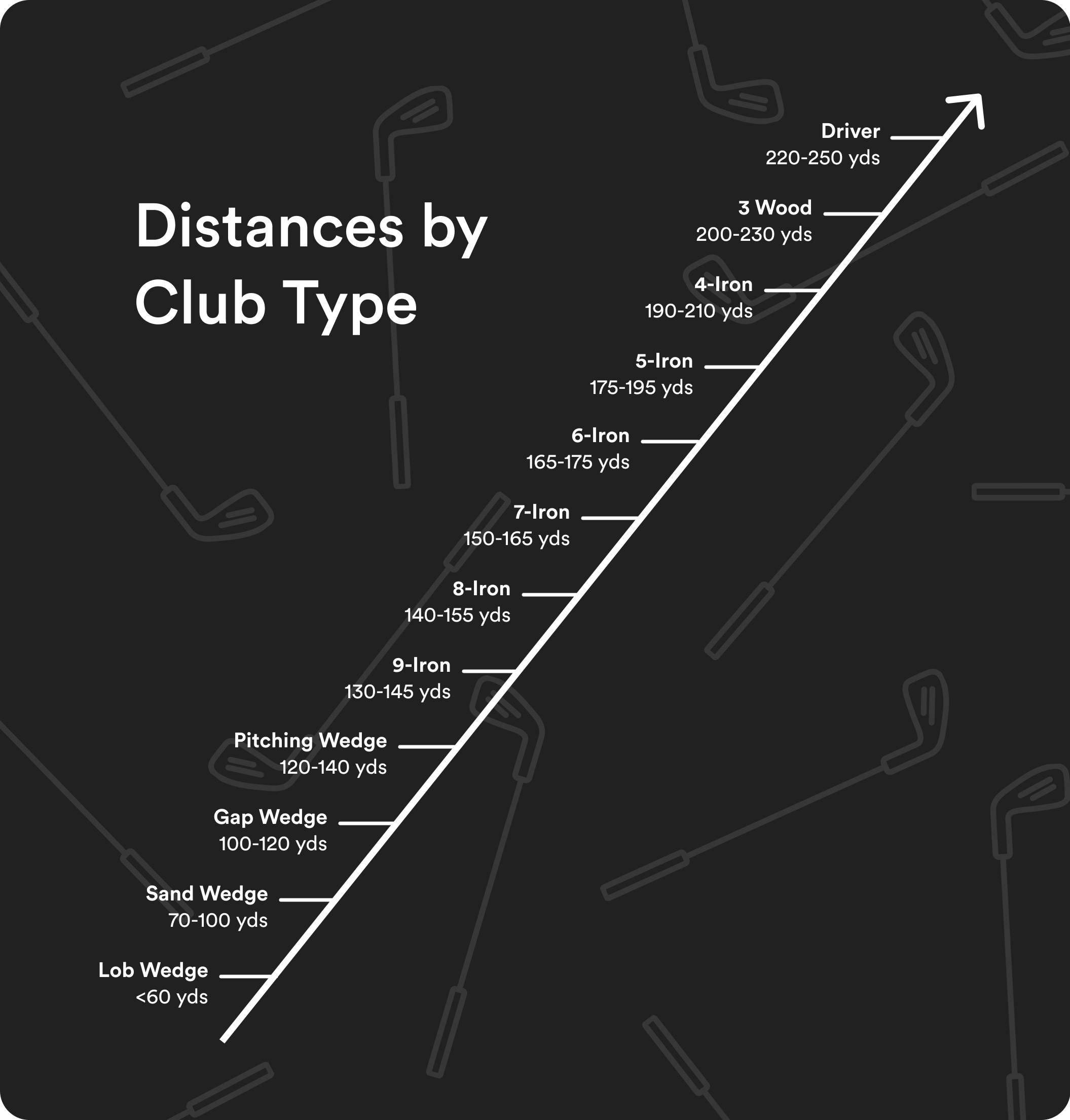Understanding the distances you can achieve with each golf club is crucial for improving your game. This guide will help you grasp the average distances for each club and the factors influencing these distances.

Key Factors Affecting Distance
Swing Speed
Faster swing speeds generally result in longer distances. Swing speed is one of the most crucial factors affecting how far you can hit the ball. Golfers with higher swing speeds can achieve greater distances.
Ball Speed
The speed at which the ball leaves the clubface affects distance. This speed is influenced by the quality of contact between the club and the ball. Clean, solid contact maximizes ball speed.
Smash Factor
This ratio of ball speed to clubhead speed measures efficiency. A higher smash factor indicates a more efficient transfer of energy from the club to the ball.
Clubhead Speed
Higher clubhead speeds can lead to longer shots. This is the speed of the clubhead at the moment of impact with the ball.
Ball Contact
Hitting the ball cleanly and in the center of the clubface ensures maximum distance. Off-center hits can significantly reduce distance and accuracy.
Weather Conditions
Wind, temperature, and humidity can affect how far the ball travels. For instance, a headwind can reduce distance, while a tailwind can increase it.
Altitude
Higher altitudes can increase distance due to thinner air, which provides less resistance to the ball.
Player Skill Level
More experienced players can often hit the ball further and with better control. Skill level affects consistency, swing mechanics, and the ability to maximize club performance.
Types of Clubs and Their Average Distances

Drivers
Used for long tee shots. Average distance: 230-270 yards. Drivers are designed for maximum distance and typically have the lowest loft among all clubs.
Woods
- 3-Wood: 210-230 yards. Used for long fairway shots or off the tee on shorter holes.
- 5-Wood: 190-210 yards. Easier to hit than a 3-wood and useful for approach shots.
Hybrids
Versatile clubs replacing long irons. Average distance: 170-210 yards. Hybrids combine the distance of woods with the accuracy of irons.
Irons
- 3-Iron: 180-200 yards. Least lofted iron, used for long shots.
- 4-Iron: 170-185 yards.
- 5-Iron: 160-170 yards.
- 6-Iron: 150-160 yards.
- 7-Iron: 140-150 yards.
- 8-Iron: 130-140 yards.
- 9-Iron: 120-130 yards. Most lofted among the numbered irons, used for shorter approach shots.
Wedges
- Pitching Wedge: 110-120 yards. Used for approach shots and chipping.
- Sand Wedge: 90-100 yards. Designed for bunker shots and short approaches.
- Lob Wedge: 60-90 yards. High loft for short, high shots around the green.

Player Styles and Club Selection
Players’ Style Clubs
Designed for skilled players with more control. These clubs offer precision and workability but require consistent ball striking. They typically have smaller heads, less offset, and thinner top lines.
Example: Titleist 620 MB irons.
Game Improvement Clubs
Help average golfers hit longer, straighter shots. They offer more forgiveness and are easier to hit. These clubs usually have larger heads, more offset, and wider soles to help get the ball airborne easily.
Example: Callaway Mavrik irons.
Players Distance Clubs
Combine elements of both for balanced performance. They provide good distance and some workability, catering to a wide range of golfers. These clubs offer a mix of forgiveness and control, making them suitable for mid-handicap players.
Example: TaylorMade P790 irons.
Practical Tips for Measuring Your Distances
Use a Launch Monitor
These devices provide accurate shot data, including distance, ball speed, and launch angle. They are widely used by professionals and serious amateurs.
Practice at the Driving Range
Hit multiple balls with each club and note the average distance. Consistent practice helps establish reliable distance data.
Track On-Course Performance
Record distances during actual rounds for a realistic measure. Pay attention to the conditions and the clubs used during different shots.
Frequently Asked Questions
Q: Why do my distances vary?
A: Variations can be due to inconsistent swings, weather conditions, or ball contact. It’s essential to work on swing mechanics and consistency to reduce variability.
Q: Should I rely on average distances?
A: Use them as a guide, but always consider specific conditions and personal comfort. Individual distances can vary based on numerous factors.
Q: Can I increase my club distances?
A: Yes, by improving swing mechanics, strength, and flexibility. Professional coaching and regular practice can also help.
Q: How often should I measure my distances?
A: Regularly, as changes in your swing, fitness, or equipment can affect distances. Keeping your data up-to-date ensures more accurate club selection.
Knowing your golf club distances is essential for better game management. By understanding the factors that affect distance and regularly measuring your personal averages, you’ll be equipped to make smarter decisions on the course. Happy golfing!
